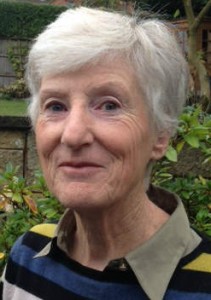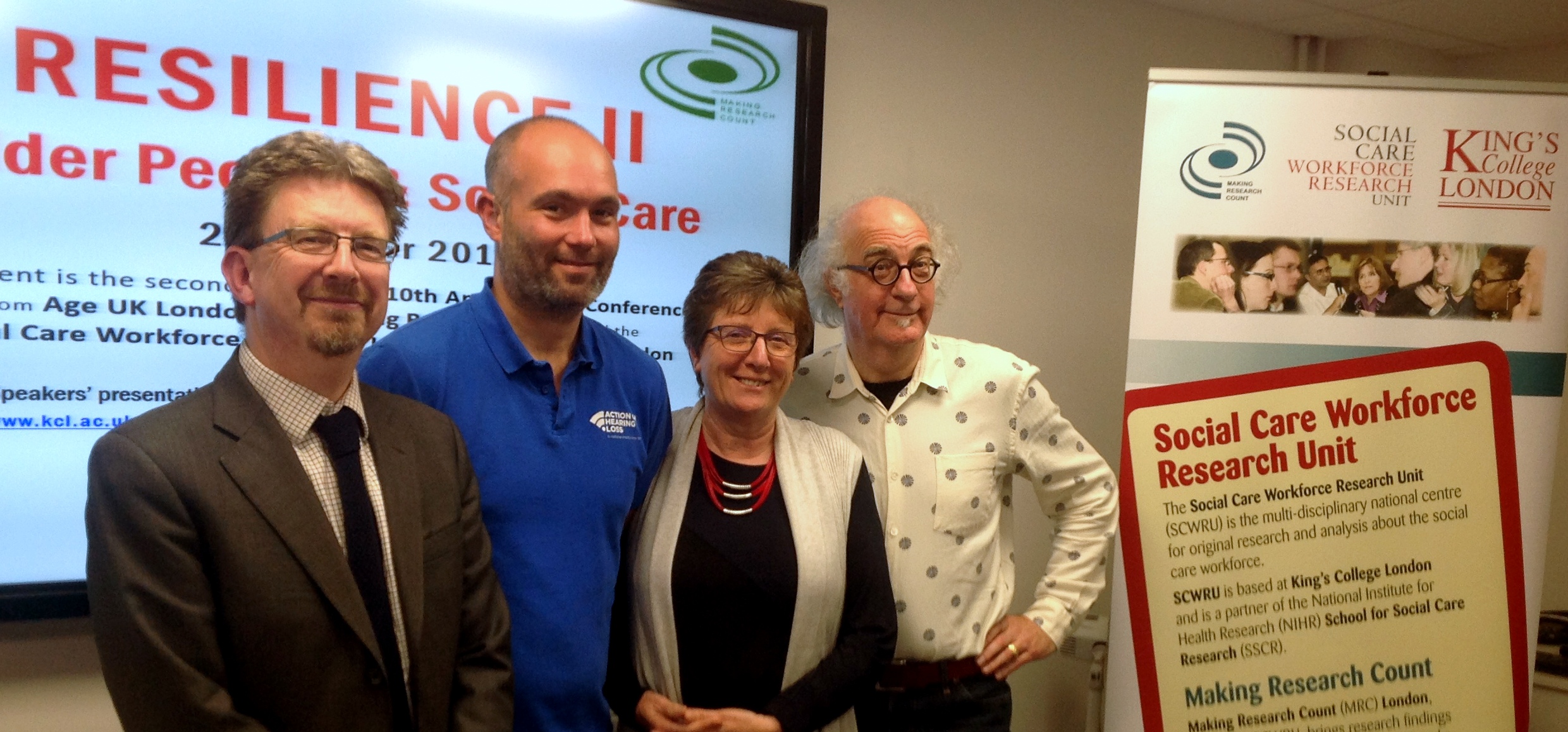Joan Rapaport was inspired at a conference organized by the Social Care Workforce Research Unit at King’s College with London Age UK London and Making Research Count, that was also supported by the British Society of Gerontology. She provides her views of the event. Presentations are available on the conference website. (1,282 words)
was inspired at a conference organized by the Social Care Workforce Research Unit at King’s College with London Age UK London and Making Research Count, that was also supported by the British Society of Gerontology. She provides her views of the event. Presentations are available on the conference website. (1,282 words)
In his welcome, Paul Goulden, Director of Age UK London explained that the conference was the second half of the Annual Joint Conference which had been held in March but was curtailed because of snow storms. This was indeed an event that had tested everyone’s resilience and explained why this conference was being held again thanks to the speakers and to the overall organizer, Jess Harris.

Paul Goulden, Daniel Webster, Lynne Phair and Dave Martin at the conference held at Age UK London’s offices in Bloomsbury on 29 October
Using the Sit&See Tool to capture and celebrate Care and Compassion for Older People: Lynne Phair, Independent Consultant Nurse and Expert Witness
When investigating an allegation of hospital neglect, a manager had asked Lynne: ‘How do I know if staff are caring and compassionate?’ This started her on the road that ultimately led to the development of the Sit&See Tool, designed to capture care and compassion.
Lynne described ‘care’ as an intervention, whilst ‘compassion’ adds the feeling and emotional connection. Compassion is part of humanity – how we regard one another. We know it but we often don’t consciously think about it. The ‘how’ relates to how we take the person to the loo, given them a drink, etc. Compassion may be witnessed in the attention paid, such as small actions that may convey thoughtfulness, involvement and recognition of the person’s feelings. The how is influenced by how staff themselves feel cared about and valued. All staff, including cleaners and kitchen workers, are important components of the care jigsaw. When staff show they are providing care in a compassionate way, this should be celebrated.
The Sit&See Tool captures, celebrates and nurtures care and compassion through agreed standard descriptors using quantitative and qualitative measures. Observations may take place every 15 – 50 minutes. Lynne provided an example of the possible ways an intervention, such as giving a person a drink, may be evaluated:
- Positive care: smile and eye contact.
- Passive care: slight acknowledgement.
- Poor care: drink put down without human contact – a tick-box exercise.
This Tool powerfully highlights the components of good patient-centred care and compassion.
Hearing Matters: Support and Hearing Loss: Daniel Webster, Regional Information Coordinator, Action on Hearing Loss
Of the 67 million people in the UK, about 11 million have hearing loss. Approximately 80,000 – 120,000 use British Sign Language (BSL) to communicate. An estimated further 500,000 experience difficulty using the telephone. Hearing difficulties are likely to increase as more people are living for longer. Causes include damage to the cochlea, environment and genetic factors, head trauma and the consequences of disease.
Daniel explained that people tend to cover up hearing loss and often resort to guesswork. On average someone takes 10 years to accept that their hearing is deteriorating. Hearing loss is often a hidden disability. People with hearing loss are likely to feel isolated because of communication barriers, frustration and anxiety when trying to access information and may give the appearance of anger when struggling to understand important advice, such as travel announcements.
Daniel used a powerful audience participation exercise to convey the feelings of frustration often experienced where hearing is compromised. He further explained that lip-reading is not always successful because of beards, people covering their mouths, or turning away when they are speaking.
Tinnitus, or ringing in the ears, also causes hearing difficulties. About 1 in 10 of us has this. The cause is unknown and there is no cure. Management of the condition may include relaxation, diet and exercise, support groups, clinics and counselling. Equipment such as hearing aids may sometimes help.
When communicating with people with hearing loss it is important to be alert and sensitive to their difficulties, to be patient and give them time, and to speak clearly rather than shout. A good place to talk should be found and communication should take place face to face. People with hearing impairments should take action to deal with their hearing loss and not ignore it or joke about their situation.
BSL has been a recognised language since 2003 but it is not legally enforced. Five schools are currently piloting BSL as a GCSE.
Daniel encouraged people to contact Action on Hearing Loss for more information.
‘Transitions in Later Life: Restor(y)ing Retirement’: Helping people in mid to later life feel better supported to manage changes as they age: Dave Martin, Associate, Centre for Policy on Ageing
‘Restor(y)ing Retirement’ is a project being undertaken with the Calouste Gulbenkian Foundation. An evaluation has recently started. Dave highlighted the generally negative attitudes to ageing and asked: can resilience be taught? People in their mid-50s to 70s have a ‘what next moment’, some look forward to retirement, whilst others are terrified of it for all sorts of different reasons. Traditionally retirement ‘courses’ have focused on advice, money and health problems. Up until now there have been few programmes about the positive aspects of the potential of ageing. The first evaluation phase of Restor(y)ing Retirement includes elements such as mindfulness, storytelling and practical aspects. These components are undertaken with partners who are interested in changing ways of thinking about ageing. Phase Two will focus on working with partners who will deliver the programme.
The Restor(y)ing Retirement programme is not prescriptive and builds on what works. It is experiential, uses homework and is grounded in the respective localities of attendees. Dave explained that they are discovering that many people do not appear to have the concept of human agency and self-determination. Those people are being encouraged to do things for themselves. Perhaps consider starting a business? Some have not talked through their expectations of retirement with their partners and the implications of being together 24/7.
Dave described ‘resilience’ as preparation for proactive adaptation and the art of ‘bouncing back’. Some participants have reported that they have found the course very helpful, particularly sharing and reflecting on their own and each other’s stories. Dave suggested that throughout life it is important to know where you are and who you are, in order to be able to bounce back. Livability and the Churches have shown interest in the whole life course approach, in contrast to public sector services, which tend to focus on retirement and old age.
Questions and group discussion
How does the Sit&See Tool help less compassionate staff to change? Lynne suggested it was important to focus on and highlight the examples of positive care as evidence to show others how they might improve. If staff cannot make the necessary changes this would highlight the ways in which they were unsuitable for the job.
Care and compassion and how we do things across the life course should be part of the education and work culture. Humanity should be part of the life course. If people do not feel valued for what they do, training is a waste of money. What we do well should be celebrated. It is important to ensure that people who are providing care feel proud of their achievements. Observations and feedback about small acts of kindness and compassion can have a big impact on the individual and on the wider staff culture.
Retirement can be a continuum of the working life where outside activities have been kept up. However, some people have more choices about work and retirement than others. Individuals who have had to work long hours may be disadvantaged. Whilst the raised retirement age could be beneficial, for others working in jobs requiring heavy physical work, it could be a real burden and a possible health hazard.
The conference ended with a powerful message that negative images of ageism can be life shortening when internalised by individuals. Coming together with others facing similar challenges and decisions and tackling them collectively and creatively should be celebrated as an inspiring approach. Ideas for next year’s conference are being considered and suggestions are welcome.
Joan Rapaport is Visiting Research Fellow at the Social Care Workforce Research Unit, Policy Institute at King’s.